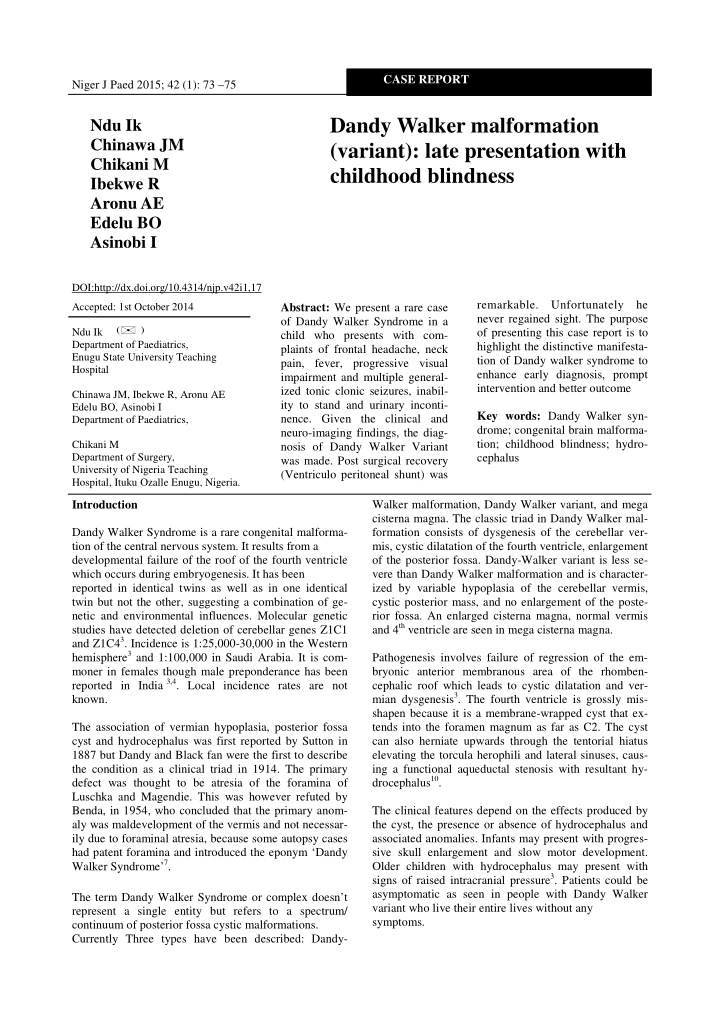



CASE REPORT Niger J Paed 2015; 42 (1): 73 –75 Dandy Walker malformation Ndu Ik Chinawa JM (variant): late presentation with Chikani M childhood blindness Ibekwe R Aronu AE Edelu BO Asinobi I DOI:http://dx.doi.org/10.4314/njp.v42i1,17 remarkable. Unfortunately he Accepted: 1st October 2014 Abstract: We present a rare case never regained sight. The purpose of Dandy Walker Syndrome in a ( ) Ndu Ik of presenting this case report is to child who presents with com- Department of Paediatrics, highlight the distinctive manifesta- plaints of frontal headache, neck Enugu State University Teaching tion of Dandy walker syndrome to pain, fever, progressive visual Hospital enhance early diagnosis, prompt impairment and multiple general- intervention and better outcome ized tonic clonic seizures, inabil- Chinawa JM, Ibekwe R, Aronu AE ity to stand and urinary inconti- Edelu BO, Asinobi I Key words: Dandy Walker syn- nence. Given the clinical and Department of Paediatrics, drome; congenital brain malforma- neuro-imaging findings, the diag- tion; childhood blindness; hydro- Chikani M nosis of Dandy Walker Variant Department of Surgery, cephalus was made. Post surgical recovery University of Nigeria Teaching (Ventriculo peritoneal shunt) was Hospital, Ituku Ozalle Enugu, Nigeria. Introduction Walker malformation, Dandy Walker variant, and mega cisterna magna. The classic triad in Dandy Walker mal- Dandy Walker Syndrome is a rare congenital malforma- formation consists of dysgenesis of the cerebellar ver- tion of the central nervous system. It results from a mis, cystic dilatation of the fourth ventricle, enlargement developmental failure of the roof of the fourth ventricle of the posterior fossa. Dandy-Walker variant is less se- which occurs during embryogenesis. It has been vere than Dandy Walker malformation and is character- reported in identical twins as well as in one identical ized by variable hypoplasia of the cerebellar vermis, twin but not the other, suggesting a combination of ge- cystic posterior mass, and no enlargement of the poste- netic and environmental influences. Molecular genetic rior fossa. An enlarged cisterna magna, normal vermis and 4 th ventricle are seen in mega cisterna magna. studies have detected deletion of cerebellar genes Z1C1 and Z1C4 3 . Incidence is 1:25,000-30,000 in the Western hemisphere 3 and 1:100,000 in Saudi Arabia. It is com- Pathogenesis involves failure of regression of the em- moner in females though male preponderance has been bryonic anterior membranous area of the rhomben- reported in India 3,4 . Local incidence rates are not cephalic roof which leads to cystic dilatation and ver- mian dysgenesis 3 . The fourth ventricle is grossly mis- known. shapen because it is a membrane-wrapped cyst that ex- The association of vermian hypoplasia, posterior fossa tends into the foramen magnum as far as C2. The cyst cyst and hydrocephalus was first reported by Sutton in can also herniate upwards through the tentorial hiatus 1887 but Dandy and Black fan were the first to describe elevating the torcula herophili and lateral sinuses, caus- the condition as a clinical triad in 1914. The primary ing a functional aqueductal stenosis with resultant hy- drocephalus 10 . defect was thought to be atresia of the foramina of Luschka and Magendie. This was however refuted by Benda, in 1954, who concluded that the primary anom- The clinical features depend on the effects produced by aly was maldevelopment of the vermis and not necessar- the cyst, the presence or absence of hydrocephalus and ily due to foraminal atresia, because some autopsy cases associated anomalies. Infants may present with progres- had patent foramina and introduced the eponym ‘Dandy sive skull enlargement and slow motor development. Walker Syndrome’ 7 . Older children with hydrocephalus may present with signs of raised intracranial pressure 3 . Patients could be asymptomatic as seen in people with Dandy Walker The term Dandy Walker Syndrome or complex doesn’t variant who live their entire lives without any represent a single entity but refers to a spectrum/ symptoms. continuum of posterior fossa cystic malformations. Currently Three types have been described: Dandy-
Recommend
More recommend